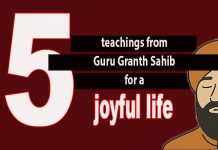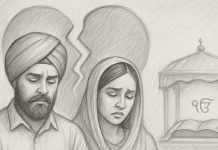
By Gurnam Singh | Opinion
Legacies of independence: Religious fanaticism – the opium of the mobs’
Aug 14th and 15th 1947 represent the birth of two nations born out of ‘British India, namely, Pakistan and India, respectively. No doubt much pomp and ceremony will be on display in both countries over the coming days celebrating ‘freedom’ from the shackles of colonialism. But when an 8-year-old child can be accused of blasphemy and potentially killed, as well as the regular spasms of so-called ‘communal’ violence that continues to curse both countries, one is required to ponder, what independence? what freedom? What a mess!
The idea that an 8-year-old child, who allegedly ‘intentionally’ urinated on a carpet in the library of a madrassa where religious books were kept, should be convicted and potentially executed under Pakistan’s blasphemy laws is both absurd and inhumane. In truth, this kind of mob violence is instigated by a small number of unscrupulous individuals, who have little regard for piety and faith. By sadly, it is an all too familiar story in the Indian sub-continent famed for its religious fervour and devotion.
We must not forget that much of the communal strife in the subcontinent has its antecedents in the racial divide and rule policies and ideologies deployed by the British Imperialists during the days of the Raj. Religion was pitched against religion, community against community, and caste against caste. And through these policies, friendships were made and broken, families were ruined, geographical lines were created and destroyed, history distorted, traditions corrupted, and most of all, hearts, minds, and bodies were shattered. And the pinnacle of this ‘achievement’ of “divide et impera” or divide and rule is symbolised by the carnage that took place during these months and days leading up to what was essentially the partition of Kashmir, Punjab, and Bengal, in 1947. And today, we are left with divided peoples and 3 bogus nations run by corrupt neofascist religious nationalists.
Ironically, the British colonialists painted a picture of being honest, civilised, rational brokers, when in fact they were the real instigators of violence and hate. There are complex reasons why the kinds of mob violence took place in the Hindu Temple in the Rahim Yar Khan district of Panjab in Pakistan, but one cannot deny they, in part, reflect the ongoing hate-filled legacies of empire and divide and rule strategies adopted by the British. This incident took place in my beloved homeland of Punjab. However, the Punjab that I recognise and love is not the one characterised by such mob violence, religious fanaticism, religious or secular fascism, caste divisions, or violence against women, but the one that reflects the humanitarian and anti-sectarian thought and poetry of Baba Nanak, Guru Arjan, Sheikh Farid, Kabeer, Ravidas, Shah Hussain, Ali Haider, Sultan Bahu, Bulleh Shah, Waris Shah, Khwaja Ghulam Farid, Allama Iqbal, and many others.
For sure nobody has the right to desecrate text, or building, secular or religious, and such acts must be subject to legal sanction. However, a true believer would never accept the absurdity of ‘blasphemy laws’. For true believers, the strength of their faith would be evidenced in their response to provocation and not the kinds of mob behaviour. If one examines the primary texts of all the great faiths, there is one overall absolute message, and that is peace, love, compassion, and freedom of conscience. Let us not forget the literal meaning of Islam is ‘peace. If one believes in an all-powerful God, then one must accept that it would be impossible to hurt, damage, insult, or otherwise God.
Hence, those speaking sacrilegiously about God or sacred things need to be understood not as individuals that are necessarily motivated by a reasoned set of beliefs, but most likely but as lacking maturity, knowledge, and being misled and manipulated by others. In such circumstances, fur sure any criminal damage caused and sentiment hurt needs to be dealt with, but not violence! One wonders, what the great prophets may have advocated, and I am pretty sure violent punishment would certainly not have been on their minds.
All faith communities, be they Sikh, Muslim, Hindu, Christian, Buddhist, or Jew, have their extreme fringe of hate mongers, though, thankfully they constitute a tiny number. Often dressed in religious garb, they will present themselves as defenders of their faith and play judge and jury to justify all kinds of acts of violence. Let me say on the record, I believe these people are NOT the defenders of faith; they are the ones that bring faith into disrepute, not an 8-year-old child who, at such a young age, cannot know what blasphemy really is about! And so, in a paradoxical sense, the real blasphemers are those who advocate and commit violence in the name of defending the honour of their prophets and even ‘God’!

Gurnam Singh is an academic activist dedicated to human rights, liberty, equality, social and environmental justice. He is an Associate Professor of Sociology at University of Warwick, UK. He can be contacted at Gurnam.singh.1@warwick.ac.uk
* This is the opinion of the writer and does not necessarily represent the views of Asia Samachar.
RELATED STORY:
Miracles and Godmen (Asia Samachar, 31 July 2020)
Towards a more loving, sharing and caring world in 2021 (Asia Samachar, 22 Dec 2020)
ASIA SAMACHAR is an online newspaper for Sikhs / Punjabis in Southeast Asia and beyond.Facebook | WhatsApp +6017-335-1399 | Email: editor@asiasamachar.com | Twitter | Instagram | Obituary announcements, click here |
































